BIOGRAPHY
| Child, Lee | Reacher |
| Chung, Candice | Chinese parents don’t say I love you |
| Courtenay, Adam | My Father Bryce |
| Norris, Peter | The bank robber’s boy |
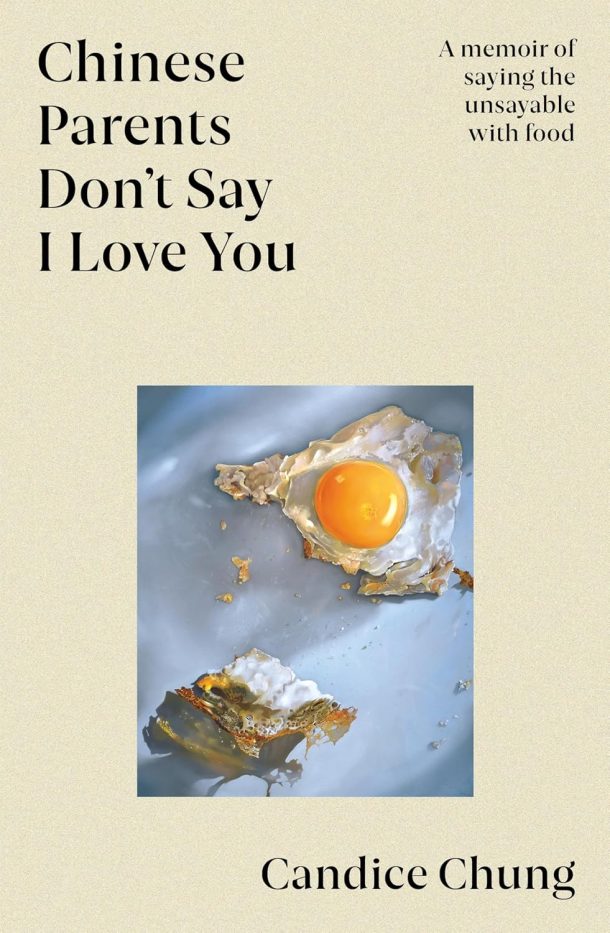 Chinese Parents Don’t Say I Love You by Candice Chung
Chinese Parents Don’t Say I Love You by Candice Chung
Mainly, this is a love story. This memoir of a certain time in Candice Chung’s life does cover a vast territory of family and meals and cooking, but it is more than that. It is a record of living and loving in Covid times, and it is about finding happiness. If you can imagine the result of mixing Julie Powell’s Julie and Julia: My Year of Cooking Dangerously with Jenny Offill’s Dept. of Speculation and sprinkling it with Nora Ephron’s Heartburn, then you are close to understanding this wonderful book. It is the perfect weekend read. You may already know Chung’s writing work from her restaurant reviews and articles in magazines and newspapers, where she writes with grace and generosity. Her first long-form work takes as its premise the time after Chung’s 13-year relationship ends and she begins to take her retired Cantonese parents to the restaurants she is reviewing. Over meals – a $40 scampi burger, anyone? – they begin to share their lives and heal a distance that had emerged throughout her previous relationship. Memories from family holidays and outings emerge, sacrifices are acknowledged, and delicious literary influences are celebrated. (The Choose-Your-Own-Adventure/hotel buffet passages are a particular delight to read.) And then, just before Covid restrictions fall over the world, Chung meets another partner. And everything changes, except the need to keep sharing meals. Chung has written a highly original memoir that asks big questions of its reader. It asks us to stop and pause for a moment; to contemplate family, language and history, alongside the true meaning of hospitality. This is the type of read that will make you laugh, underline passages and truly consider cooking an octopus on a Tuesday evening. I mean, how long could it take? Read Chinese Parents Don’t Say I Love You to find out. You will not be disappointed. Readings, April 2025.
Return to top
COOKING
| Persson, Melanie | The Very Hungry Coeliac’s gluten free feasts |
Return to top
GENERAL FICTION
| Aoyama, Michiko | The healing hippo of Hinode Park |
| Barclay, Linwood | Whistle |
| Brunnbauer, Holly | What did I miss? |
| Dettmann, Jessica | Your friend and mine |
| Forsyth, Frederick | Revenge of Odessa |
| Green, Sophie | Lessons in love at the seaside salon |
| McFadden, Freida | The surrogate mother |
| Parker, Alli | Until the red leaves fall |
| Rimmer, Kelly | The Midnight Estate |
| Salmon, Carla | We saw what you started |
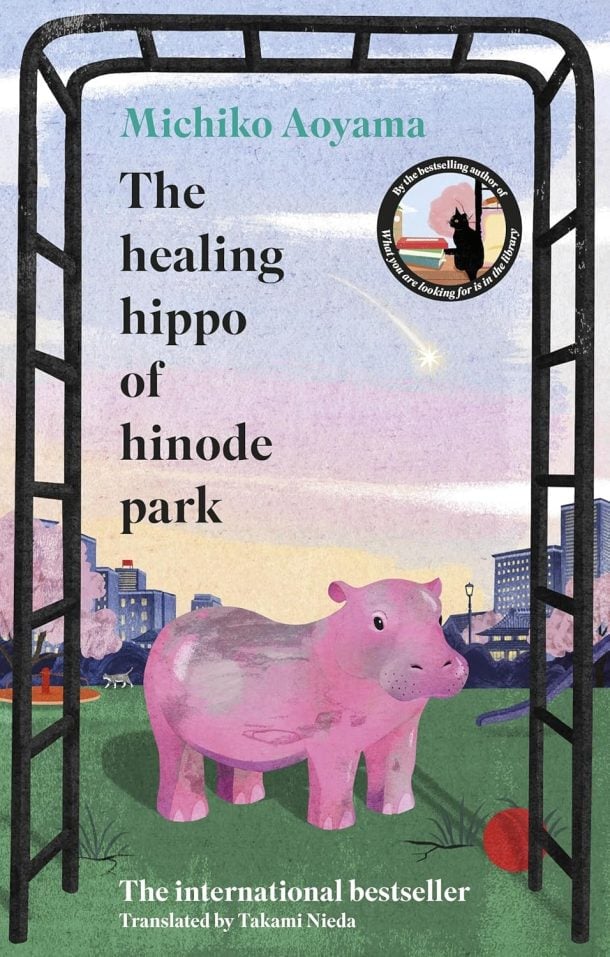 The healing hippo of Hinode Park by Michiko Aoyama
The healing hippo of Hinode Park by Michiko Aoyama
A collection of vignettes centered around the families living in a five-story condominium near Tokyo. Five stories intertwine in this novel that moves up from the first to fifth floor homes in the Advance Hill condominium building shortly after it’s built. Each story offers a new, carefully wrought point of view from one of the residents in that condo. Schoolchildren like Kanato and Yuya who have just moved to the area; a mother, Sawa, who’s trying to figure out her place in the world now that her daughter has started kindergarten; Chiharu, a 20-something wedding planner who is lonely and hoping for love; and Kazuhiko, a late-middle-aged magazine editor who has decided to move closer to his mother in the hopes of being able to help her. What ties them all together is a small, stationary children’s ride at the park: a hippo named Kabahiko. Legend in the neighborhood is that if you touch Kabahiko on the part of his body where you yourself are injured, you will be healed. And each narrator discovers the truth of this—but it isn’t magic. Instead, healing comes in the way in which each person’s interactions with Kabahiko creates introspection that leads to enlightenment and a better understanding of the wider community. As Kazuhiko notes, “The thought of strangers living under the same roof, each with their own hopes and burdens, warmed my heart a little.” Together, this is a sweet—perhaps overly sweet—set of stories that offers up the sentiment that sometimes what ails you can be traced back to a problematic point of view. But each story alone is enough to spark thoughtfulness and a small glow of happiness. Read them one at a time. Kirkus Reviews, July 2025.
 Whistle by Linwood Barclay
Whistle by Linwood Barclay
Barclay (I Will Ruin You) delivers a harrowing supernatural thriller centered around a model train set. In 2001, seven-year-old Jeremy receives a toy engine for Christmas and ties one of his sister’s dolls to the tracks. When the train strikes the doll, a glass shatters in the kitchen, severing one of his sister’s fingers. Decades later, bestselling children’s author Annie Blunt is haunted by the death of a six-year-old fan who was attempting to fly like one of her characters. Then her husband is killed in a hit-and-run. Grief-stricken, Annie flees Manhattan with her son and settles in the small Vermont town of Lucknow for the summer. On their first night there, Annie hears a train whistle, only to learn, the next morning, that no trains run nearby. Then two locals disappear, and one is found without his hair, teeth, and bones. Toggling between 2001 and the present day, Barclay gradually focuses in on Choo-Choo’s Trains, a mysterious Lucknow novelty shop that seems to be connected to a spate of tragedies. As the horror mounts, Barclay grounds the action through the eyes of his well-developed protagonist, offering scares and pathos in equal doses. It’s a top-shelf chiller. Publisher’s Weekly, July 2025.
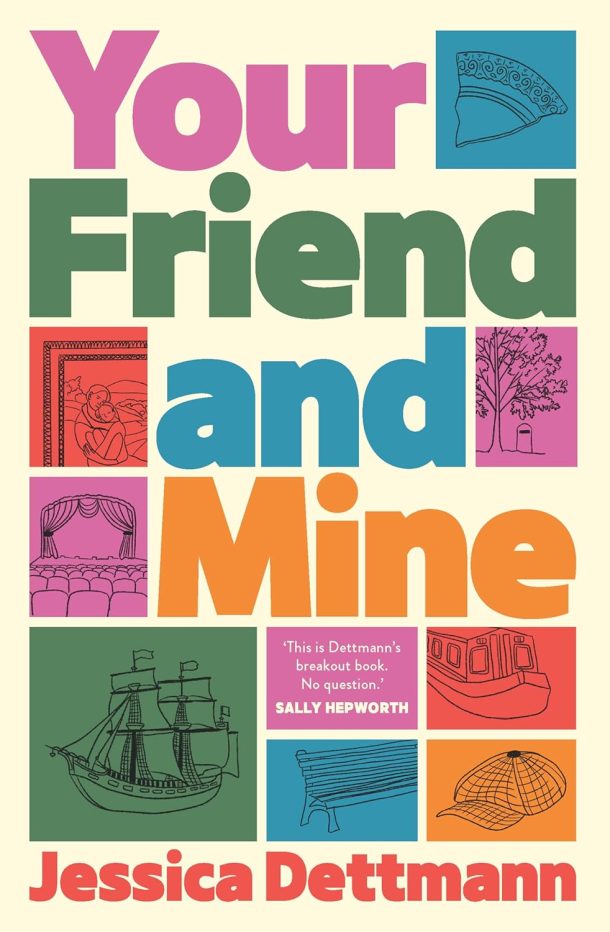 Your Friend and Mine by Jessica Dettman
Your Friend and Mine by Jessica Dettman
From the very first pages, Your Friend and Mine has a compelling premise. Out of the blue, 42-year-old Sydney restaurateur Margot receives an email from her best friend, Tess. But Tess tragically died from ovarian cancer 20 years earlier. Tess has left behind a gift: a fully funded trip to London, the adventure they had planned to take together in their 20s before life got in the way. But there’s a catch. Margot must complete a series of tasks to scatter Tess’s ashes in specific locations, and she won’t be doing it alone. Tess has arranged for her stepbrother, Leo, to meet Margot in London and accompany her, and within days Margot is on a plane. At first glance, the set-up hints at a classic romantic arc. But Dettmann takes a different path, delivering a thoughtful exploration of long-term relationships, personal growth, and how our values shift over time. Margot’s journey is not just about honouring Tess’s memory – it’s about confronting the past. As the trip unfolds, she realises she never truly knew Tess. Through a series of letters accompanying each task, Tess reveals long-held secrets, leaving Margot questioning, and ultimately rediscovering herself. I thoroughly enjoyed the twists and turns of Margot and Leo’s journey – both physical and emotional. This book is a heartfelt, beautifully crafted story, offering a much-needed escape and a poignant reminder of the ways friendship, love, and loss, shape us. A lovely antidote for our troubled times. Good Reading Magazine, July 2025.
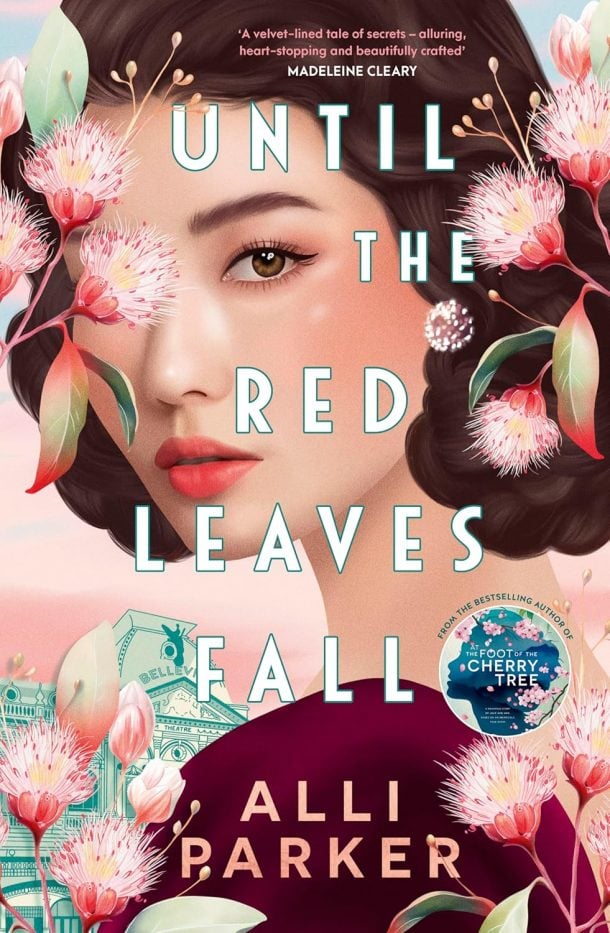 Until the Red Leaves Fall by Alli Parker
Until the Red Leaves Fall by Alli Parker
In 1957 Melbourne, memories of the war and Japanese brutality are still fresh. Emmy Darling keeps her history secret: her real name is Emiko Tanaka and she and her Japanese-Australian family were interned by the Australian Government after Pearl Harbour. A talented writer, Emmy’s career has been sidelined as she plays the role of good wife to celebrated playwright Sebastian. But a chance meeting with theatre royalty Virginia van Belle opens the door for Emmy to write her own play. She keeps it secret from Sebastian and plans to tell her family’s story. But Virginia has other ideas and Emmy is dismayed when Virginia insists on rewrites that will transform her story from personal history to stereotypical cliché. Just when she feels she can step into a more fully realised version of herself, Emmy is confronted by how dangerous the truth can be. Will she tell a good story or a true story? Set against the glamourous backdrop of the theatre world, Until the Red Leaves Fall offers a fascinating insight into a slice of Australian history: fear and racism engendered by war, shame around divorce and homosexuality, and men’s power compared to women’s limited freedoms. Emmy’s story is powerful and moving. Good Reading Magazine, August 2025.
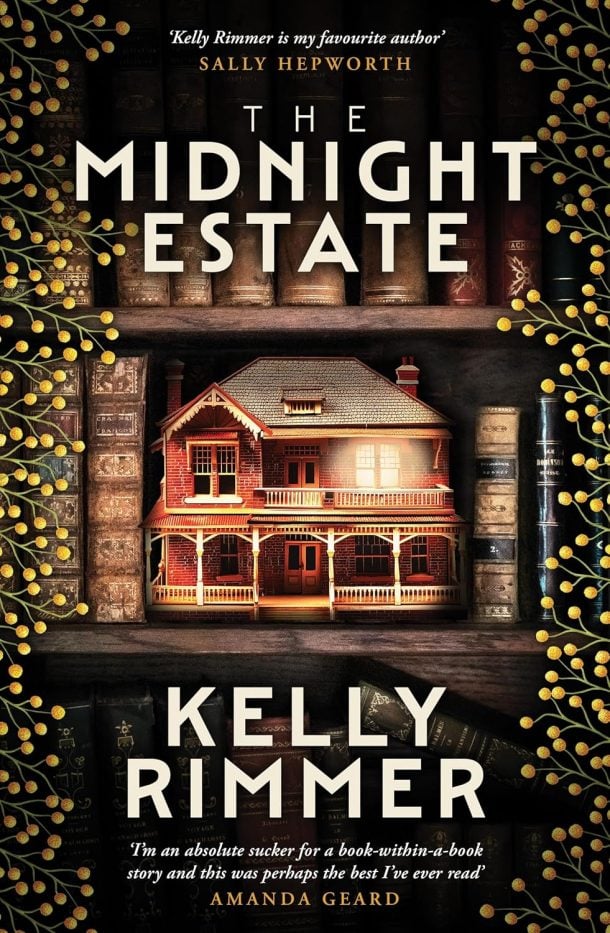 The Midnight Estate by Kelly Rimmer
The Midnight Estate by Kelly Rimmer
Fiona, newly turned 50, is blindsided by the revelation that her husband, Lucas, is having an affair with her best friend, Keira. The betrayal is compounded by the fact that all three are partners in a successful architectural firm. Lucas offers to buy Fiona out, on the condition that she won’t set up in competition. Ready to escape the chaos, Fiona walks away from both the business and her old life. Seeking a fresh start, she returns to her childhood home in the town of Forbes to the once-glorious mansion Wurimbirra, a place filled with fond memories. The house had belonged to her beloved Uncle Tad, a celebrated but eccentric writer, and now sits abandoned and crumbling. He bequeathed the house to his son Jon. Unlike Fiona, Jon’s memories haunt him. Though hesitant, Jon – her cousin and lifelong friend – agrees to sell the property to Fiona. From the moment she moves in, strange things begin to happen: inexplicable noises, broken objects and an overwhelming sense of unease. Her mother reacts with unexpected fury at the purchase. Fiona discovers a box of books by an author she’s never heard of. The novel, The Midnight Estate, draws her in, and she begins to suspect it holds clues to Wurimbirra’s haunted past. The Midnight Estate is a clever, compelling read – its ‘book within a book’ structure is executed with skill, adding depth and intrigue to an already engaging plot. Rimmer masterfully blends mystery, family secrets, and emotional resilience into a gripping narrative that spans generations. The story keeps you immersed from the first page to the final reveal. Good Reading Magazine, August 2025.
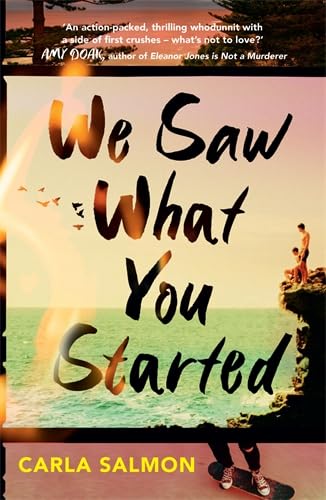 We Saw What You Started by Carla Salmon
We Saw What You Started by Carla Salmon
Carla Salmon’s debut novel, We Saw What You Started, is set in Red Sands, a classic Australian coastal town with a ‘barefoot and boardshorts’ summer holiday vibe, where Instagram-worthy scenery attracts tourists and the local kids hang out at the beach or skate park. Teenage siblings Jasper and Milly are vying to be named surf club captain – Jasper with his larrikin charm and Milly driven by a desire to be taken seriously by their father. Meanwhile, newcomer Otto, a Californian surfer trying to rebuild his life after being implicated in a devastating fire back home, is starting to feel a sense of belonging in Red Sands – until a bushfire breaks out in the nearby national park. When a series of suspicious arson attacks follow, Otto quickly becomes the prime suspect. With growing distrust of the police, escalating danger, and a threatening local bully, the teens decide to take matters into their own hands, launching an investigation in true Nancy Drew fashion. Told in alternating perspectives from Otto and Milly, the novel explores complex moral questions around honesty, integrity and responsibility – both in relationships and within a broader community still grappling with trauma. It also engages with themes of expectations, single-parent families, harassment and cyber-bullying. Otto and Milly’s distinct voices broaden the book’s appeal across genders, while the twist-filled plot, subtle romance, evocative setting, well-defined characters and sprinkling of mischief make for an absorbing read. A confident addition to the recent spate of strong YA mysteries, We Saw What You Started is recommended to readers aged 12+. Books+Publishing, May 2025.
Return to top
HISTORICAL FICTION
| Brooks, Karen | The whisky widow |
| Byrnes, John | Sins of the fathers |
| Escobar, Mario | A bookseller in Madrid |
| O’Connor, Mary-Anne | The Stowaway |
| Parker, Kaarina | Fulvia |
| Spencer, Jonathan | Emperor of dust |
| Wood, Daisy | The banned books of Berlin |
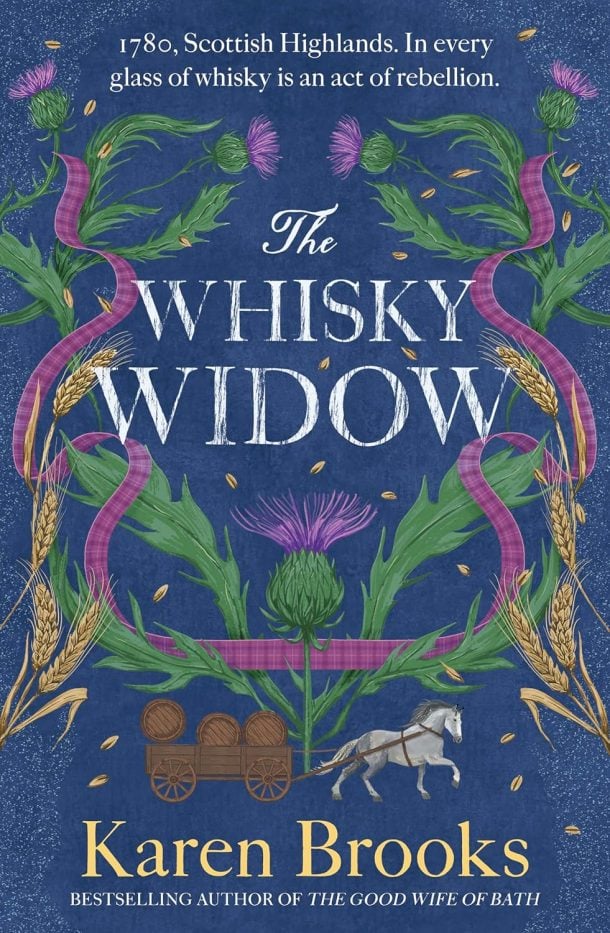 The Whisky Widow by Karen Brooks
The Whisky Widow by Karen Brooks
Anyone who believes that all Scots are alike obviously does not know their history. Those living in the Lowlands of Scotland had a hearty disregard for Highlanders, a sentiment returned in full by said Highlanders. Brooks, based in Tasmania, and with a family interest in brewing and distilling, has revealed these differences in her rollicking story of 1780s Scotland, the black economy of the area fuelled by illegal whisky-making, and the impact on a village by the arrival of a strong-minded Lowlander, a woman from Edinburgh. Not only was Greer Reed an ‘incomer’ who did not understand Gaelic, but she was the widow of an English excise officer. She became housekeeper for widowed Tam Gordon, cousin of the clan laird. Tam held the village together, with its members scratching a subsistence living and needing their many illegal whisky stills to pay annual rents to the laird and provide an income. Greer became an integral part of village life. Her deaf daughter, who had learned ‘finger talk’ at a school for the deaf in Edinburgh, eventually taught many villagers, with that sign language vital for the smugglers taking their whisky along back roads. Whisky really was the major currency, used for bribing officials, offered at all hours to family and friends, given to women giving birth and even their minutes-old babies. This story, involving enmity and murder, is set around the start of the Clearances, when many Highland villages were replaced by sheep farms. Brooks’ research into that time revealed the women running stills as well as households, enmity felt to English militia and excise officers by Highlanders, and fierce loyalty to their whisky-fuelled way of life. There is mystery in this novel, a swearing pastor, romance and even the possibility of faeries. It is as subtle and fiery as a Highland whisky. Good Reading Magazine, August 2025.
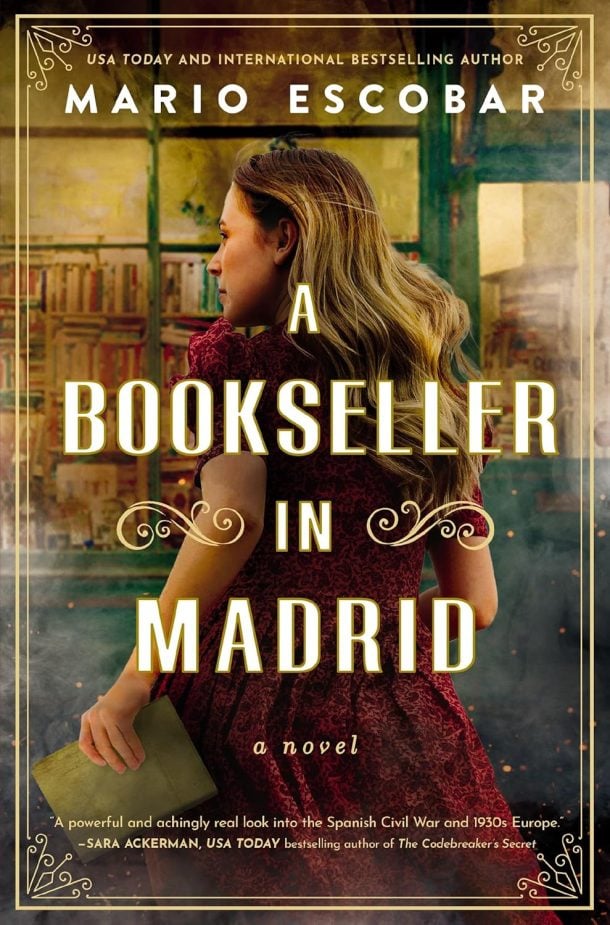 A Bookseller in Madrid by Mario Escobar
A Bookseller in Madrid by Mario Escobar
Finding an old book in the trash in present-day New York City frames the story of Barbara, a young woman in early 1930’s Berlin whose life’s goal is to open a bookshop covering a wide range of ideas. Political events intervene, however, and she moves from the frying pan of Berlin into the fire of Madrid. She reconnects with Juan Delgado, a man she met in Berlin, then opens her shop, marries Juan, and becomes involved in the political upheaval of revolutionary Spain. There is intrigue, danger, and privation as Barbara is forced to spy for the British to earn asylum for her father, and to spy for the Germans to save her family. The ties she maintains to a German Lutheran school that has been active in Spain for generations becomes their lifeline. While told in a somewhat old-fashioned style, the story is dramatic and engaging, and readers willing to suspend their disbelief will appreciate the ending. Escobar’s latest (after The Forgotten Names, 2024) is a worthy read as present-day occurrences echo events of the past. Booklist, June 2025.
Return to top
MYSTERY
| Austen-Leigh, Lois | The incredible crime |
| Blake, Matthew | A murder in Paris |
| Carnac, Carol | Impact of evidence |
| Gardner, Lisa | Kiss her goodbye |
| Kenway, Lisa | All you took from me |
| Kepler, Lars | The sleepwalker |
| Kirk, J. D. | Thicker than water |
| Leitch, Fiona | The Cornish wedding murder |
| MacBride, Stuart | This house of burning bones |
| Mackintosh, Clare | Other people’s houses |
| Marais, Bianca | A most puzzling murder |
| McCloskey, David | Moscow X |
| Nesbo, Jo | Wolf hour |
| Rao, Nilima | A Shipwreck in Fiji |
| Rose, Karen | Knife in the back |
| Ryan, Iain | The dream |
| Sutherland, Claire | The crag |
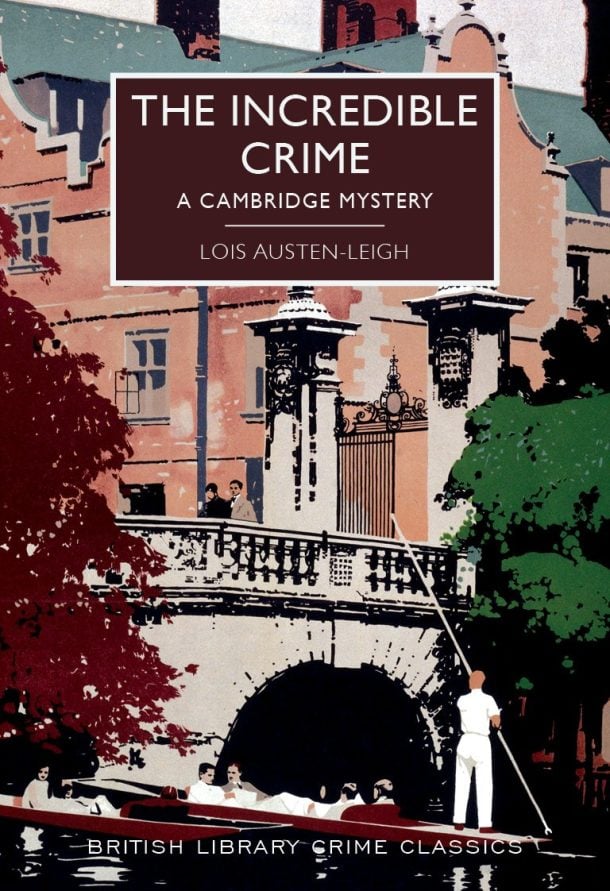 The Incredible Crime by Lois Austen-Leigh
The Incredible Crime by Lois Austen-Leigh
Miss Prudence Pinsent, daughter of the master of Prince’s College at Cambridge, epitomizes her time and place in this first mystery by Jane Austen’s great-great-niece, originally published in 1931 and now reissued for the first time. Prudence has tea with the faculty wives and serves as hostess when her father entertains the Cambridge dons, but she’s far too fond of her independence to marry. When the college fellows become too tiresome, she heads to Wellende Hall, where her cousin Ben, Lord Wellende, lives for hunting and sport. On her way to Suffolk, she stops for lunch at a country inn, where she spots Harry Studde, an old childhood friend. Capt. Studde is now an Inspector of the Coast Watchers, and in this capacity he’s noticed clear signs of smuggling through Wellende Hall. The family and their tenants have been smugglers for centuries—a boat can run from the coast up the river right into the cellars of Wellende Hall—but this smuggling is nastier stuff: an addictive new drug known only as X.Y.X. What’s worse is that someone in Cambridge is distributing the drug throughout the country. How many of Prudence’s family and friends may be caught up in this wretched business? While the mystery is slight, the vivid evocation of a fox hunt, the disconcertingly pre-feminist courtship, and the placid conviction that blood will tell make for fascinating period detail of a world mystery lovers all too often see only through the lens of imaginative hindsight. Recommended to all mystery fans. Kirkus Reviews, March 2017.
 Kiss Her Goodbye by Lisa Gardner
Kiss Her Goodbye by Lisa Gardner
Gardner’s riveting fourth Frankie Elkin novel (after Still See You Everywhere) focuses on an Afghan refugee family’s fight for survival. After recovering from a traumatic case, Frankie heads to Tucson, where Sabera Ahmadi has gone missing shortly after her family’s arrival in Arizona. The police have yet to open a missing person’s file, believing it’s a simple case of Sabera fleeing her domineering husband, but Sabera’s best friend contacts Frankie because she refuses to believe Sabera would leave her three-year-old daughter behind. She’s proven right when Sabera’s husband vanishes soon after, and then an unseen assailant attempts to abduct the couple’s daughter from their home. Frankie leaps into action, but when Sabera is caught on video surveillance running from the scene of a double homicide, it becomes clear that there’s more to the story than meets the eye. Gardner punctuates the proceedings with pages from Sabera’s journal detailing her life before and after leaving Afghanistan, helping readers feel her absence as acutely as the other characters do. Heartbreaking violence and masterful suspense elevate things further. This will thrill the series’ existing fans, and it’s a great starting point for newcomers. Publisher’s Weekly, May 2025.
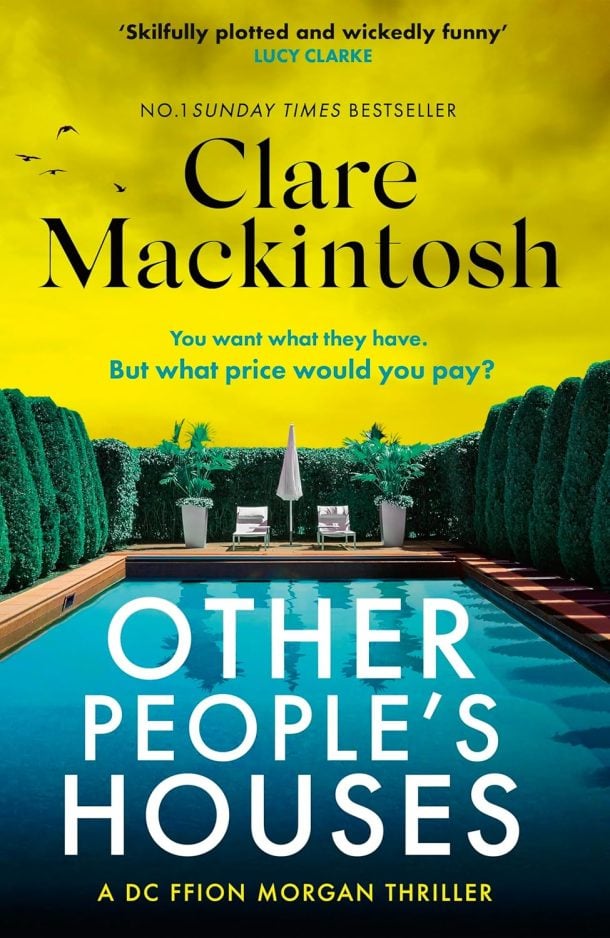 Other People’s Houses by Claire Mackintosh
Other People’s Houses by Claire Mackintosh
A spate of robberies collides with murders past and present in Mackintosh’s solid third outing for Welsh Det. Constable Ffion Morgan (after A Game of Lies). When a woman is found dead in a kayak on the bank of the Awen River, near the border between Wales and England, Ffion’s superiors assign her the case. At the same time, Ffion’s boyfriend, Det. Sgt. Leo Brady, is looking into a series of burglaries just across the water in an exclusive Tottenham neighborhood called the Hill, where his social climbing ex-wife lives alongside influential bankers, professional soccer players, and bored housewives. While the lovers work on their respective cases, Ffion ravenously consumes the latest season of the popular true crime podcast Without Conviction, which covers a gruesome decade-old double homicide that went cold—and might hold key information about Ffion’s current investigation. Mackintosh smoothly braids her three main plot threads, infusing the action with humor and surprising sweetness. Though it’s not quite as ambitious as previous installments, mystery readers of all stripes will find something to like. Publisher’s Weekly, June 2025.
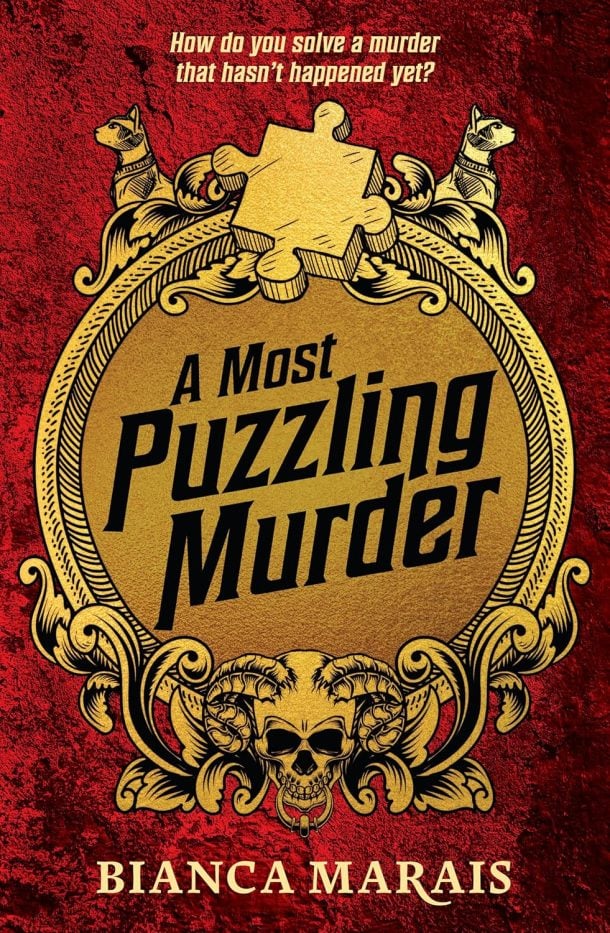 A Most Puzzling Murder by Bianca Marais
A Most Puzzling Murder by Bianca Marais
An orphaned “enigmatologist” works feverishly to discover her true parentage and prevent a murder. Brilliant young Destiny Whip is contemplating a bleak future and bantering with her annoying best friend, bossy Bex, when the arrival of a mysterious letter from one Mordecai Scruffmore changes everything. The writer captures her inquisitive imagination, offering her a position as the Scruffmore family historian and promising access to a vault full of secrets from all over the world. Thus begins a labyrinthine odyssey for the heretofore isolated Destiny. Along the way, the reader is invited to join Destiny as she faces a series of 16 puzzles she must solve to reach the ultimate answer, the identity of her mother. These include word puzzles, number puzzles, hieroglyphs, and more. There’s often a solving tip included in a footnote: “If you’re a fan of the movie Fight Club, you’ll have all the information you need to solve this minipuzzle.” As the character names indicate, the prose is frothy and frivolous, with a Victorian patina reminiscent of Ronald Firbank. New sets of characters are introduced periodically, not so much to deepen the mystery as to add some diverting froufrous. These include blacksmith Ian Montgomery, who lives on Eerie Island; Gabriel Morezzi, closely involved in an earlier incident when Destiny barely escaped death; and chatty siblings Hexabus, Newton, and Tempest. Their details, like so many others here, remain cloudy but fanciful. Enjoy the prose but don’t sweat the mystery. Just read on for the next puzzle. A cheeky, convoluted whodunit, with a bonus collection of puzzles…or vice versa? Kirkus Reviews, April 2025.
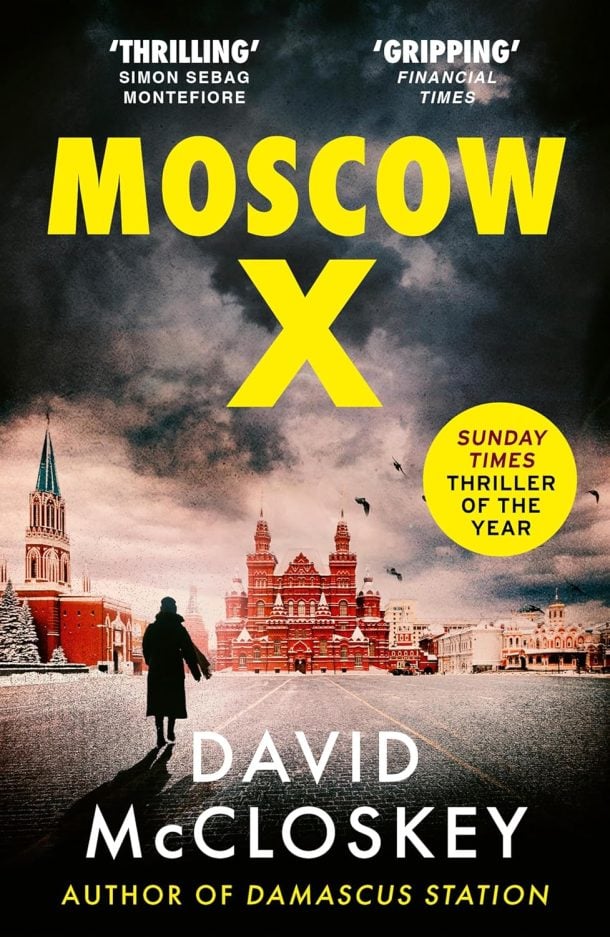 Moscow X by David McCloskey
Moscow X by David McCloskey
America and Russia don’t play nice in a tale that mixes spies, horses, and gold bullion. Moscow X is a secret CIA operation designed to cause migraines for the Russian government, especially for Vladimir Putin. “Access to Putin’s money would give us beautiful opportunities for fuckery and general mayhem,” declares Artemis Aphrodite Procter, formerly the CIA’s Chief of Station in Tajikistan. Her hands already “wet with Russian blood,” she jumps at the chance to join Moscow X. At about the same time, Lieutenant Colonel Chernov of the Federal Security Service (FSB) illegally transfers 221 bars of gold from Bank Rossiya, although it’s theft on Putin’s behalf. “What is to be done when the police are robbing you?” wonders a bemused banker. Chernov demonstrates that “the law is nothing but ritual, it is a glorious gesture of subjugation to our leader.” Anyway, the gold belongs to Russia, which in turn belongs to God. Therefore, it’s God’s gold, so the “withdrawal” is ultimately legitimate. (Nice reasoning!) Putin has a financial stake in RusFarm, a Thoroughbred horse operation. Anna Agapova has deep ties to the Russian establishment, but she meets sub rosa with the CIA. She is a complex character who has troubled relationships with her husband and her country, but whether she becomes a traitor to her homeland remains to be seen. A nice detail: She carries a lipstick gun, the “Kiss of Death,” which plays an unexpected role in the story. The cast of well-developed characters also includes Hortensia “Sia” Fox, a “hot-shit NOC” (non-official cover) who wants a Russian scalp, and there are nasty villains like Anna’s husband. The story builds a bit slowly at first, but the tension grows as well. There’s a reference to overthrowing Putin, but that doesn’t seem like the point. Procter has it right that the best analogy for U.S.-Russia relations is of “two individuals punching each other in a fight without end.” Human life and horseflesh are at risk, and the blood that eventually flows won’t tilt the balance of power in either direction. The author researched his subject deeply, and it shows. The CIA pokes the Russian bear, and thriller fans win. Kirkus Reviews, August 2023.
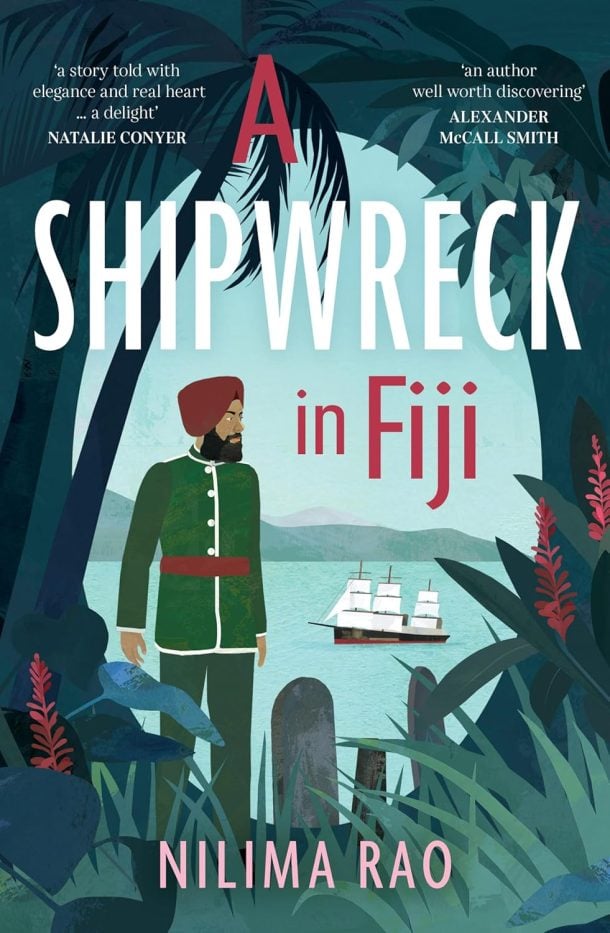 A Shipwreck in Fiji by Nilima Rao
A Shipwreck in Fiji by Nilima Rao
Rao serves up an immersive second adventure for Sikh police sergeant Akal Singh (after A Disappearance in Fiji). The year is 1915, and Singh, who has been transferred to the backwater British colony of Fiji due to an indiscretion at his former posting in Hong Kong, is still being assigned only the most inconsequential tasks by his commanding officer, inspector-general Jonathan Thurstrom. This time out, Thurstrom asks Singh to escort two visiting British ladies on their sightseeing tour of the island of Ovalau. As an afterthought, he also suggests that Singh follow up on a local shopkeeper’s report of spotting German soldiers on the island (since WWI is raging in Europe, officials consider the alleged sighting improbable at best). Accompanied by his friend and colleague Taviti Tukana—the nephew of a prominent Fijian chief—Singh tackles both assignments, only to stumble into a murder investigation when a local pariah on Ovalau turns up dead. Through Singh, who’s an outsider both to Fijians and his British superiors, Rao deploys sharp observations about colonial rule and classism. Though the book’s many subplots unfold at a leisurely pace, the author ties them together in shrewd and satisfying ways. Historical mystery fans will enjoy this. Publisher’s Weekly, March 2025.
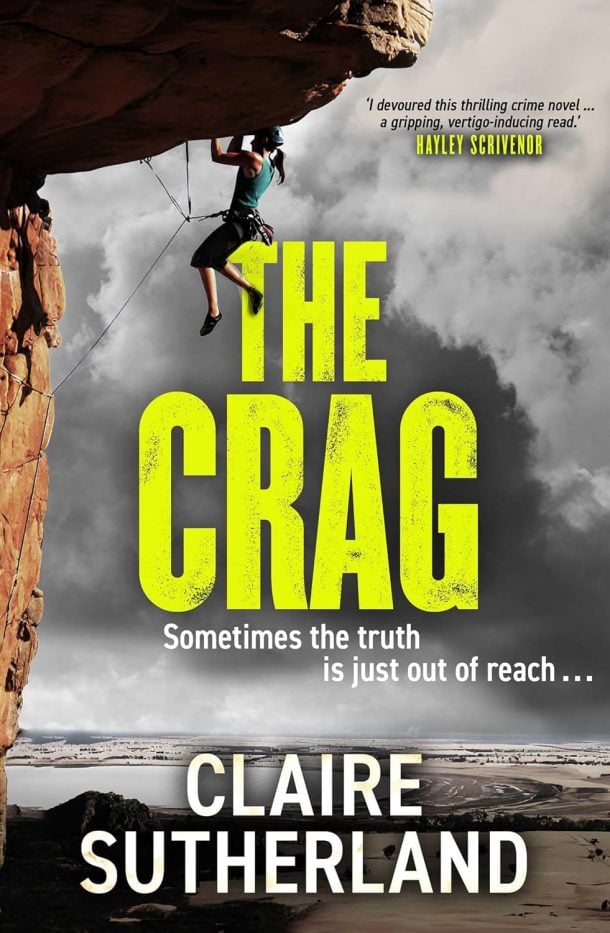 The Crag by Claire Sutherland
The Crag by Claire Sutherland
A body of a young female is found hidden in the Wimmera by a young rock-climber, Skye. All fingers point to a farmer: one who is callous, violent and a loner. Further investigations show this may not be his only victim. But something is off. The victim had injuries consistent with a rock-climbing accident but was found 5 km from any cliffs. Absolutely nothing could be linked to the farmer even though the early investigation shows the victim had answered his advertisement for work. As they continue to investigate, evidence piles up: CCTV images, lies uncovered. Although, as much evidence as they have, no links can be made to a person. The police request Skye to assist them in their investigation which gives her a thrill. But now it looks like one murder is turning into multiple murders with no clear suspect in sight. The team become increasingly frustrated until a chance conversation back in the city. Troubling thoughts grow into terrible suspicions and drastic action is needed to find the killer. A perfect future is about to be shattered. I confess, as a non rock-climber, I did, at times, find the jargon and the explanations slowed the fast-moving pace of the narrative a little for me, but it did not detract from an enjoyable read. The Crag is a good read and one I enjoyed for its unusual setting, and the fact that there was not one but two strong female characters that were both necessary for the plot to unwind, encompassing the multiple subplots and misleading turns, ultimately leading to an unexpected ending for one of our heroes. Good Reading Magazine, August 2024.
Return to top
NON FICTION
| Adams, Michael | They’ll never hold me | 364 ADAM |
| Aston, Joe | The chairman’s lounge | 387.70 ASTO |
| Caroutas, Meni | Someone somewhere knows something | 363.23 CARO |
| Johnson, Steve | A thousand miles from care | 364.15 JOHN |
| Knight, Riley | History’s strangest deaths | 306.9 KNIG |
| McDermott, Quentin | Meadow’s law | 364.15 MCDE |
| McQuire, Amy | Black witness | 302.23 MCQU |
| Mercer, Neil | The kingpin and the crooked cop | 364.15 MERC |
| Parker, Gordon | A gut mood solution | 616.89 PARK |
| Pembroke, Michael Andrew | Silk silver opium | 950 PEMB |
| Sinclair, David | Lifespan | 570 SINC |
| Thunberg, Greta | No one is too small to make a difference | 363.7 THUN |
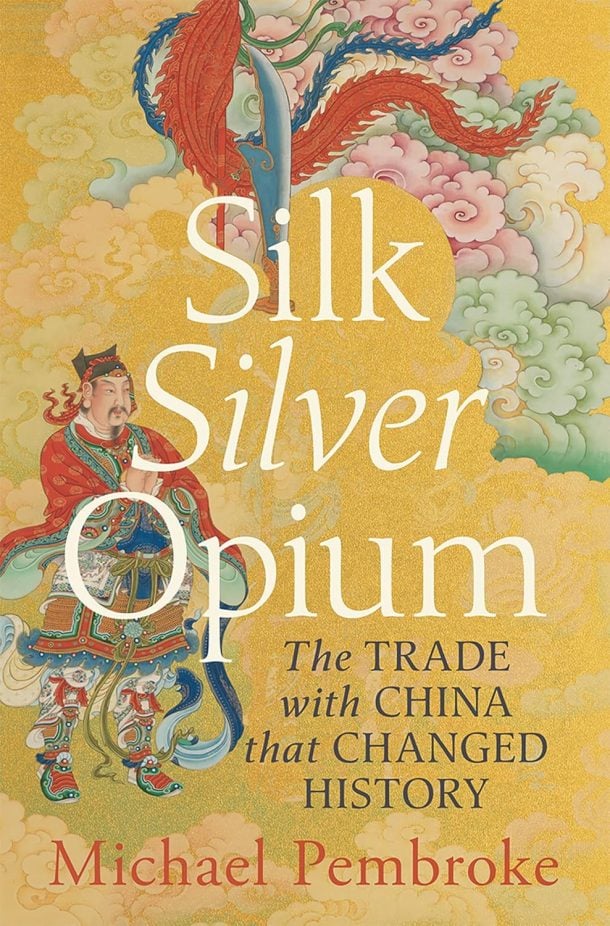 Silk Silver and Opium by Michael Pembroke
Silk Silver and Opium by Michael Pembroke
Michael Pembroke is a retired Supreme Court judge who certainly surprised this reviewer with his Play by the Rules – an excoriating critique of US foreign policy since World War II that now seems strangely prescient. There is a large literature on the Opium Wars and if you are looking for a China specialist on the subject – one who has actually read the Chinese Imperial archives – I recommend Julia Lovell’s The Opium War. William Dalrymple’s Empire podcast has also recently traversed this much-contested ground. Pembroke is a non-specialist on China, and this is essentially a work of synthesis but what it does offer is a convenient and well-researched overview of the West’s economic connections with China from the Roman period until the fall of the Chin Dynasty in 1912. For most of this period China was wealthier and technologically more advanced than the West and ran substantial trade surpluses. That changed in the 19th century for reasons that included the West’s temporary military advantage: an unpopular and increasingly inept foreign dynasty and massive internal rebellions (the Taiping and Boxer) aggravated by war indemnities. The outcome is known in China as the century of Humiliation. Anyone wanting to understand the current breakdown of the so-called Rules-Based Order and the likely direction of the West’s relationship with China needs to understand this history and Silk Silver and Opium is a good place to start. Good Reading Magazine, August 2025.
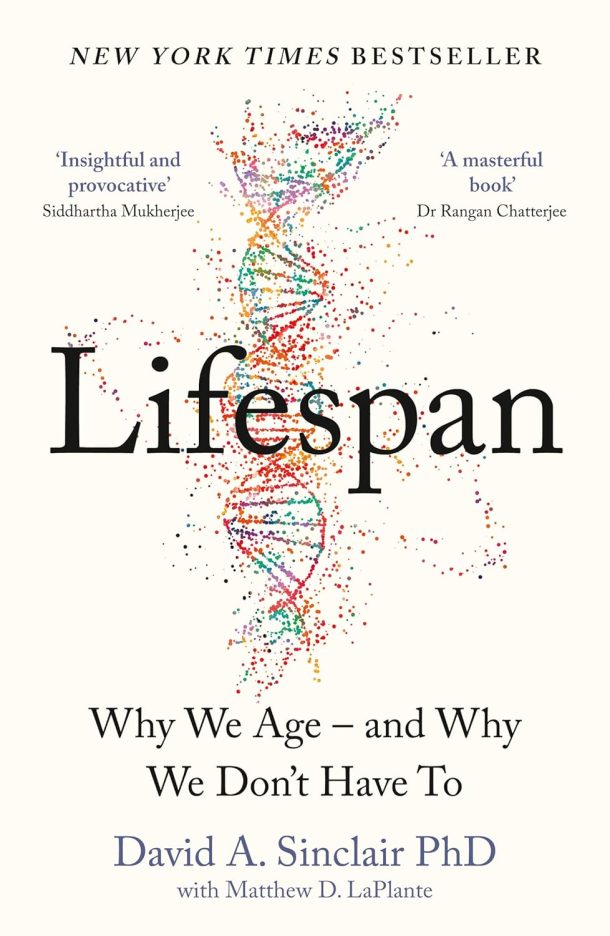 Lifespan by David Sinclair
Lifespan by David Sinclair
An uplifting review of the science suggesting that “prolonged healthy lifespans are in sight.” According to Sinclair (Genetics/Harvard Medical School), scientists have discovered what causes aging. They’ve also discovered how to treat it because, despite what doctors and philosophers have claimed throughout history, aging is not inevitable. It’s a disease. Throughout the book, the author’s enthusiasm jumps off the page. Scientifically inclined readers may be occasionally turned off by his affection for dramatic stories of individuals who defy aging, but they cannot deny that he is an acclaimed, award-winning scientist who works hard to explain his groundbreaking research and that of laboratories around the world. Beginning at the beginning, he writes that “way back in the primordium, the ancestors of every living thing on this planet today evolved to sense DNA damage, slow cellular growth, and divert energy to DNA repair until it was fixed—what I call the survival circuit.” In the 1950s, scientists discovered that DNA damage occurs throughout life. Since it’s disastrous for a cell to divide with broken DNA, repair mechanisms suppress growth and reproduction until they’re finished. Cells that don’t divide live longer. Insects and mice mature quickly, reproduce, and soon die. Elephants and whales grow slowly and live much longer lives. Cells of the bristlecone pine, the oldest of which is nearly 5,000 years old, show no signs of aging. Researchers have discovered the mechanism of growth suppression in hormones and also in genes that produce such specific enzymes. These longevity enhancers respond to stress but also to exercise, intermittent fasting, low-protein and low-calorie diets, and several pharmaceuticals that, the author assures readers, will soon emerge from the laboratory. Also in the works are DNA monitoring and reprogramming, already well advanced in animals, that can detect malfunctions and reset the aging clock. A highly optimistic review of anti-aging science that may persuade older readers that they were born too soon. Kirkus Reviews, June 2019.
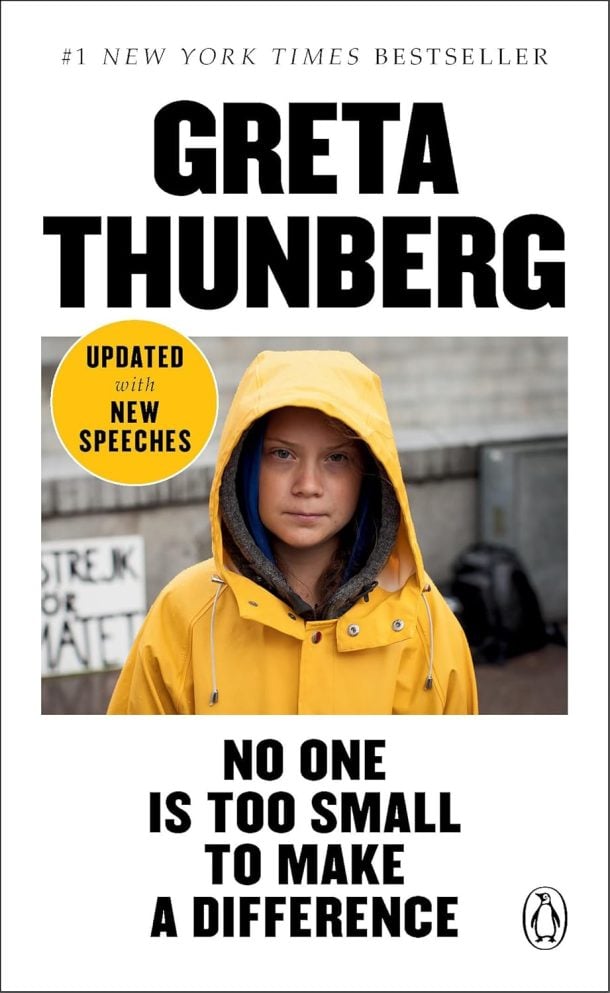 No one is too small to make a difference by Greta Thunberg
No one is too small to make a difference by Greta Thunberg
A collection of articulate, forceful speeches made from September 2018 to September 2019 by the Swedish climate activist who was nominated for a Nobel Peace Prize. Speaking in such venues as the European and British Parliaments, the French National Assembly, the Austrian World Summit, and the U.N. General Assembly, Thunberg has always been refreshingly—and necessarily—blunt in her demands for action from world leaders who refuse to address climate change. With clarity and unbridled passion, she presents her message that climate change is an emergency that must be addressed immediately, and she fills her speeches with punchy sound bites delivered in her characteristic pull-no-punches style: “I don’t want you to be hopeful. I want you to panic. I want you to feel the fear I feel every day. And then I want you to act.” In speech after speech, to persuade her listeners, she cites uncomfortable, even alarming statistics about global temperature rise and carbon dioxide emissions. Although this inevitably makes the text rather repetitive, the repetition itself has an impact, driving home her point so that no one can fail to understand its importance. Thunberg varies her style for different audiences. Sometimes it is the rousing “our house is on fire” approach; other times she speaks more quietly about herself and her hopes and her dreams. When addressing the U.S. Congress, she knowingly calls to mind the words and deeds of Martin Luther King Jr. and John F. Kennedy. The last speech in the book ends on a note that is both challenging and upbeat: “We are the change and change is coming.” The edition published in Britain earlier this year contained 11 speeches; this updated edition has 16, all worth reading. A tiny book, not much bigger than a pamphlet, with huge potential impact. Kirkus Reviews, November, 2019.
Return to top
ROMANCE
| Johnson, Debbie | The Comfort Food Cafe |
Return to top
New additions to eBooks at SMSA
EBOOKS
| General | Burge, Michael | The watchnight |
| General | Fleet, S. J. | The cut throat trial |
| General | Miranda Darling | Fireweather |
| Historical | Bergman, Anya | The tarot reader of Versailles |
| Historical | Martin, Madeline | The secret book society |
| Mystery | Conyer, Natalie | Shadow city |
| Mystery | Doak, Amy | Eleanor Jones is not a murderer |
| Mystery | Gentill, Sulari | Five found dead |
| Mystery | Spencer, Matthew | Broke road |
| Romance | Johnson, Debbie | A touch of magic at the comfort food café |
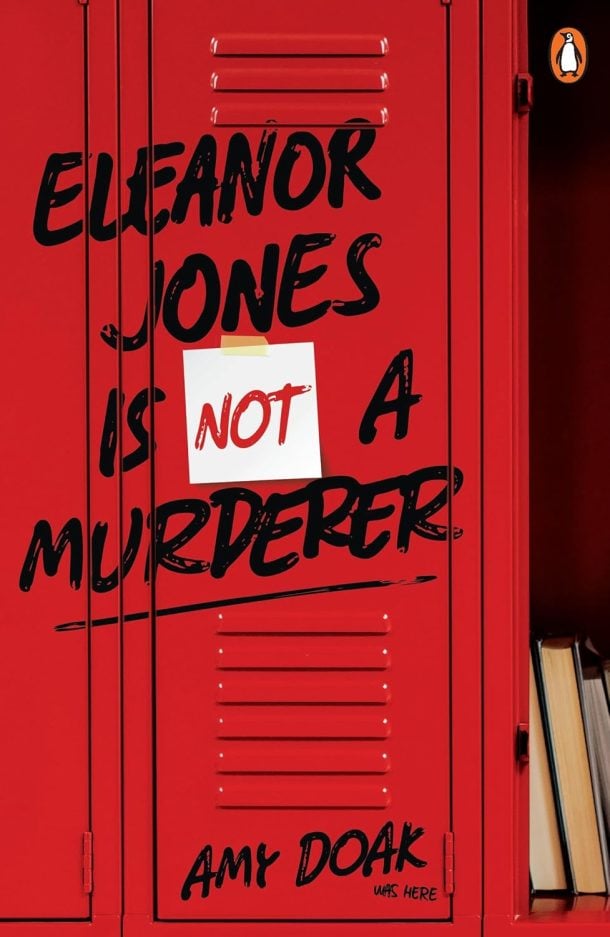 Eleanor Jones is Not a Murderer by Amy Doak
Eleanor Jones is Not a Murderer by Amy Doak
Amy Doak’s debut is a young adult mystery novel for aspiring detectives. Eleanor thinks of herself as an unexceptional person with medium hair, skin, height and shape. She likes to keep to herself and do things on her own terms, which has served her well at nine different schools over the past five years. At her new school, however, she decides to be friendly to a random boy, Angus, who is struggling with his books. But when he turns up stabbed (but alive) the next day, the cops realise Eleanor was the last person to speak to him before the attack. Eleanor realises that the cops don’t have all the information, so she sets out to put together the pieces of a puzzle that only an exceptional young woman can complete. Eleanor Jones is Not a Murderer is a tense page-turner that invites readers to sort clues and question everything around them. It’s also a book for young readers who, though clever and determined, are nonetheless facing the everyday misgivings of adolescent life. Doak has written an ode to the strength of women, believing in yourself and finally finding your people. This is a book for young feminist readers who love a mystery solved by a strong heroine. Publisher’s Weekly, July 2023
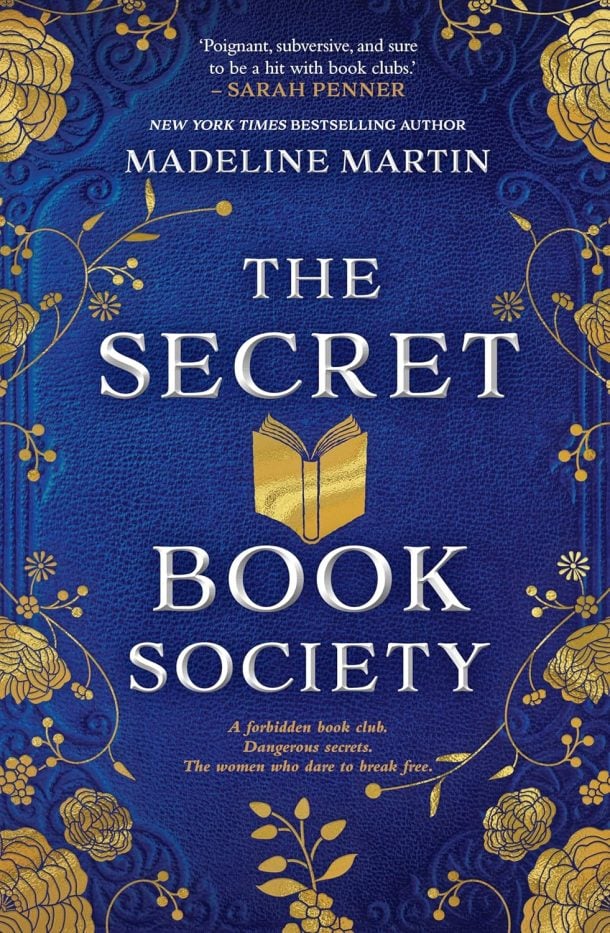 The Secret Book Society by Madeline Martin
The Secret Book Society by Madeline Martin
When the Countess of Duxbury invites three women “carefully selected for their intelligence and discretion” to form an underground reading group in the late 1890s, their shared secret hobby becomes a way to broaden their horizons and transform their sheltered lives. Their newfound courage leads to dangerous but necessary changes, particularly when one member faces commitment to an asylum by her abusive husband. Martin delivers a compelling tale of four Victorian women finding strength and friendship through forbidden literature, using evocative prose that captures the restrictions of their society and the liberation found in the written word. Fans of Martin’s previous historical novels, Natasha Lester’s The Paris Seamstress (2018), and Kate Quinn’s The Rose Code (2021) will appreciate themes of social class constraints, freedom through literature, and the use of multiple narrators to weave a tapestry of female resilience. With a compelling blend of historical detail, female friendship, and shared connections, The Secret Book Society reminds us of the surprising power of literature in our search for connection, independence, and autonomy. Booklist, July 2025.
Return to top
AUDIOBOOKS
| General | Ichaso, Chelsea | We were warned |
| General | James, Riley | The chilling |
| General | Wally Lamb | I Know This Much Is True |
| Historical | Kristy Cambron | The French Kitchen |
| Mystery | Archer, C. J. | The prisoner’s key |
| Mystery | Grace, Fiona | Cashmere conspiracy |
| Mystery | Shapiro, Irina | Murder on platform four |
| Mystery | Mallory Arnold | How to Survive a Horror Story |
| Non-Fiction | Mercer, Neil | The kingpin and the crooked cop |
| Sci-Fi/Fantasy | Clancey, Emma | This dream will devour us |
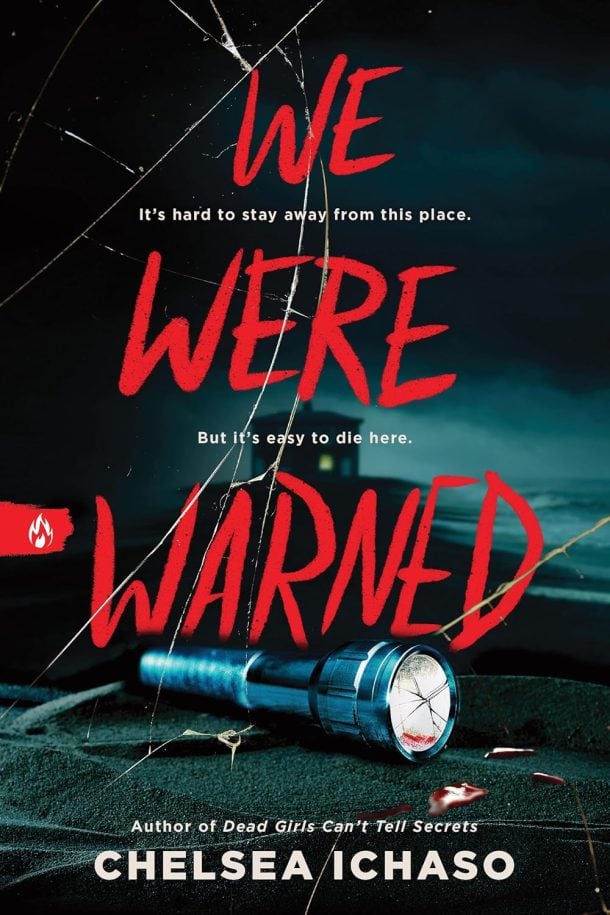 We Were Warned by Chelsea Ichaso
We Were Warned by Chelsea Ichaso
Fairport Village used to be a popular resort owned and operated by the Blackmore family, but its success vanished overnight when Mrs. Blackmore murdered her teenage son, Nicolas. Twenty-five years later, the high school’s senior class holds an overnighter at the ruined resort and a student dies, presumably murdered by the ghost of Mrs. Blackmore, similar to two other teens found dead on the grounds in years past. Eden, a senior often picked on due to a family scandal, finds herself drawn into investigating the mystery with the very people who bully her. As they dig into the past, however, it seems that someone is stalking them, as more students die mysteriously. As the first-person narrator, Eden provides an acerbic touch to the story, given her distrust of those around her. The plot spins out at a classically YA breakneck pace, providing one red herring after another and culminating in a grisly Scooby-Doo-style unmasking of the villains. An afterword also provides an unpleasant surprise. Ichaso and thriller fans will not be disappointed. Booklist, February 2025.
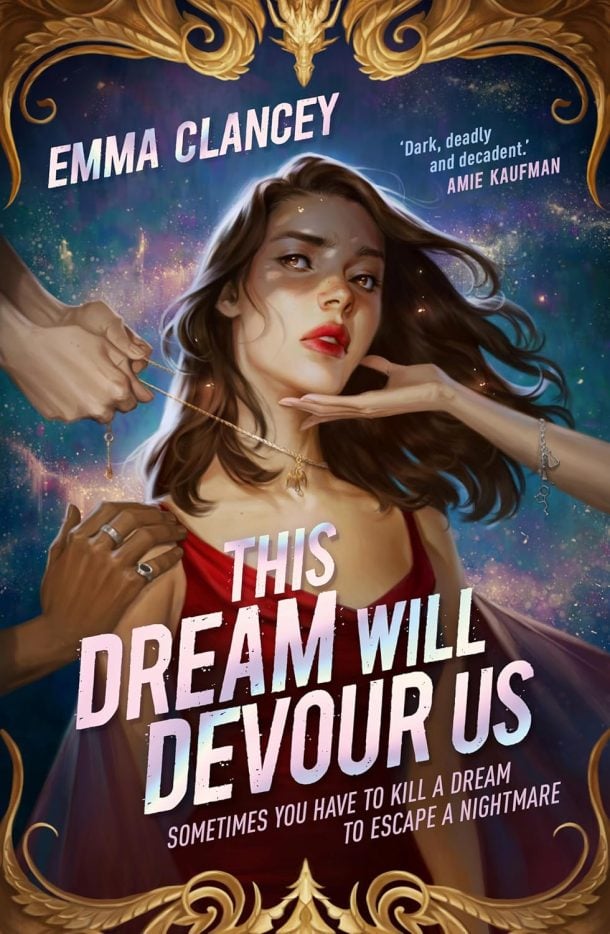 This Dream Will Devour Us by Emma Clancey
This Dream Will Devour Us by Emma Clancey
What if humanity developed a drug that could manipulate the elements – essentially perform magic? In This Dream Will Devour Us, debut author Emma Clancey builds a world where the potent substance levicium grants magical abilities but is hoarded by the billionaire Lamour family, making it only accessible to the elite. Nora, the novel’s determined heroine, knows firsthand the cost of this inequality. Fuelled by the loss of her father and needing money for her hospitalised brother, Nora yearns to become a Dream Engineer – highly-paid, magic-wielding experts funded by the Lamours. When she unexpectedly gains entry into their exclusive world, Nora strikes a precarious deal with Remy, the youngest of the Lamour brothers, in hopes of securing a coveted recommendation for the training program. Clancey’s richly imagined world deftly mirrors real-world wealth disparity, making the fantasy both thrilling and unsettlingly familiar. Her vivid descriptions of the dazzling displays of levic-magic are wondrous and grounded in biochemistry, lending an air of plausibility to the supernatural. The story takes a sharp turn in the second half, escalating into a whirlwind of unsolved mysteries, heists, elite soirees, body-swapping, cover-ups and murder. Ultimately, it’s a rollicking, fast-paced read that barrels along to a satisfying, if not expected, conclusion. With a PG-rated love triangle and plenty of excellent LGBTQI+ representation. Publisher’s Weekly, March 2025.


